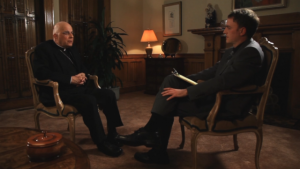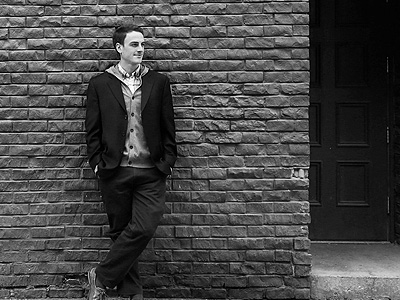



Helping us see things a bit more clearly: remembering the late Cardinal George
Sebastian Gomes
Thursday, May 14, 2015
 Cheridan and Sebastian pose with Cardinal George at his residence following an interview for The Church Alive series in 2012.
Cheridan and Sebastian pose with Cardinal George at his residence following an interview for The Church Alive series in 2012.
It’s been one month since the death of Cardinal Francis George of Chicago and personal stories and reflections continue to be shared across the media by people all over the world who either knew him or recognized his great contributions to the American Church and beyond.
I was not close to the Cardinal, but I did have the chance to meet him a number of times and on one occasion do an extended interview with him for S+L (the interview appeared in various episodes of The Church Alive). So, I’m not surprised that people continue to write about him in the weeks after his death—a trend that will continue I’m sure. Those who had the opportunity to meet him know that despite his small and fragile stature he was a giant of a man in so many ways, and the depth and richness of his Christian life warrant our enduring admiration and gratitude.
Allow me—a passerby of sorts—to contribute to the amassing collection of memories of Cardinal George and share the experience of our first meeting that remains fixed in my mind.
It was the spring of 2012 and I was part of an S+L team at DePaul University covering World Catholicism Week. Connected to the trip was an arranged interview with Cardinal George at the historic Archbishop’s residence at 1555 North State Parkway just off Lincoln Park.
It was near the beginning of my time at S+L and the interview was my first “big one”. I knew the Cardinal by reputation only: a brilliant and piercing intellect matched only by his personal warmth and gentleness. I knew less about the residence and when we arrived with the help of GPS we looked at each other in daunting disbelief.
We did have an appointment, but I remember approaching the front door feeling like Frodo Baggins and co. outside the sealed walls of Moria. We hesitatingly pressed the doorbell and a few moments later the door was slowly opened by a very serious-looking security guard (btw, we didn’t need to say “mellon”, the Elvish word for “friend”).
He didn’t say much but gestured us in, with cameras and lights in tow, and took us to an elegant room on the same floor in the north-east corner of the house. We began setting up and about 10 minutes later the Cardinal limped in—he suffered from polio from age 13—and welcomed us to his home.
He was soft-spoken off camera and very gracious. He asked us how long it would take to set up and when we told him about fifteen minutes he excused himself to take care of a few other business items.
When he returned, we told him a bit about our vision for The Church Alive series and he said, “very good, very good,” and sat down. He was particularly interested in our episode on Catholic education, a subject that was very dear to him and a longtime focus of his episcopal ministry.
We had two things in mind when we prepared the questions for the interview. First, because the show was about the new evangelization we knew we had to get back to basics, the fundamental principles of the Catholic faith. Second, we were looking at the big picture, that is, how those fundamental principles could be arranged in a comprehensive and comprehensible way for people today. So we focused on the Church’s understanding of things like education, religious liberty, the role of the media and, of course, politics.
For me sitting opposite the Cardinal, the interview was like travelling through hyperspace. I was prepared, but it was one of the few times in my care er that I became lost, in the best sense of the word, in the responses of my guest. He answered very complex questions immediately, as though they required little reflection, but used language that was simple and direct, like a calculator. He was precise, eager to go straight to the heart of the matter without wasting breath on peripheral considerations.
We had been talking about a force at work in the society, both in Canada and the US, seeking to purge all education of religious influence, and at one point I asked him what makes a Catholic education unique (as opposed to a secular or public education). Very assuredly the Cardinal said:
er that I became lost, in the best sense of the word, in the responses of my guest. He answered very complex questions immediately, as though they required little reflection, but used language that was simple and direct, like a calculator. He was precise, eager to go straight to the heart of the matter without wasting breath on peripheral considerations.
We had been talking about a force at work in the society, both in Canada and the US, seeking to purge all education of religious influence, and at one point I asked him what makes a Catholic education unique (as opposed to a secular or public education). Very assuredly the Cardinal said:
 On Further Reflection
In the complex world of the 21st century there are more questions than answers. The challenge for the Church is to find new and effective ways of bringing the Gospel message into the conversation. For her part, the Church can act as a much needed voice of dialogue, reason and charity. On Further Reflection invites readers to go beyond the headlines to see the deeper realities affecting the church and society. Sebastian Gomes is a producer and correspondent for S+L TV.
On Further Reflection
In the complex world of the 21st century there are more questions than answers. The challenge for the Church is to find new and effective ways of bringing the Gospel message into the conversation. For her part, the Church can act as a much needed voice of dialogue, reason and charity. On Further Reflection invites readers to go beyond the headlines to see the deeper realities affecting the church and society. Sebastian Gomes is a producer and correspondent for S+L TV.
 er that I became lost, in the best sense of the word, in the responses of my guest. He answered very complex questions immediately, as though they required little reflection, but used language that was simple and direct, like a calculator. He was precise, eager to go straight to the heart of the matter without wasting breath on peripheral considerations.
We had been talking about a force at work in the society, both in Canada and the US, seeking to purge all education of religious influence, and at one point I asked him what makes a Catholic education unique (as opposed to a secular or public education). Very assuredly the Cardinal said:
er that I became lost, in the best sense of the word, in the responses of my guest. He answered very complex questions immediately, as though they required little reflection, but used language that was simple and direct, like a calculator. He was precise, eager to go straight to the heart of the matter without wasting breath on peripheral considerations.
We had been talking about a force at work in the society, both in Canada and the US, seeking to purge all education of religious influence, and at one point I asked him what makes a Catholic education unique (as opposed to a secular or public education). Very assuredly the Cardinal said:
“Well a Catholic school is the only place where you can have a serious conversation. You can talk about God; you can’t do that in a government school. You can talk about our future, not only here but after this life—who are we therefore? Why do we regard people as ends and not as means? What is the source of human dignity? You can’t raise those questions in a government school. And so they’re not free. We’re free.”Later when I had time to review and process the interview, it struck me that he had this unique ability to remove the fog of complexity surrounding very significant issues and provide a rational and progressive (in the sense of forward-thinking) response. To link the issue of what can be discussed in a school with the issue of freedom of thought and speech is enormously consequential. A cry for the removal of religious matter from the education of young people is narrow and restrictive; it is precisely the opposite of freedom, and that’s why the Church opposes it. Such was the ability of Cardinal Francis George to suddenly and unexpectedly open our minds and spark our imaginations. After the interview he showed us a few monuments in the historic house and we took some photographs together. He sent his best wishes to the S+L staff and encouraged us in our work. We left on an intellectual high and confident in the direction we were taking our new TV series. There is a lot of great content in The Church Alive, but the Cardinal’s contribution was singularly profound, in my opinion. I’m grateful for having had the chance to interview him on that occasion; I will never forget that hour in which the fog was lifted and I was able to see things a little more clearly thanks to him. May he rest in peace.
 On Further Reflection
In the complex world of the 21st century there are more questions than answers. The challenge for the Church is to find new and effective ways of bringing the Gospel message into the conversation. For her part, the Church can act as a much needed voice of dialogue, reason and charity. On Further Reflection invites readers to go beyond the headlines to see the deeper realities affecting the church and society. Sebastian Gomes is a producer and correspondent for S+L TV.
On Further Reflection
In the complex world of the 21st century there are more questions than answers. The challenge for the Church is to find new and effective ways of bringing the Gospel message into the conversation. For her part, the Church can act as a much needed voice of dialogue, reason and charity. On Further Reflection invites readers to go beyond the headlines to see the deeper realities affecting the church and society. Sebastian Gomes is a producer and correspondent for S+L TV.Related Articles:
<<
SUPPORT LABEL
$50
$100
$150
$250
OTHER AMOUNT
DONATE
Receive our newsletters
Stay Connected
Receive our newsletters

Stay Connected







